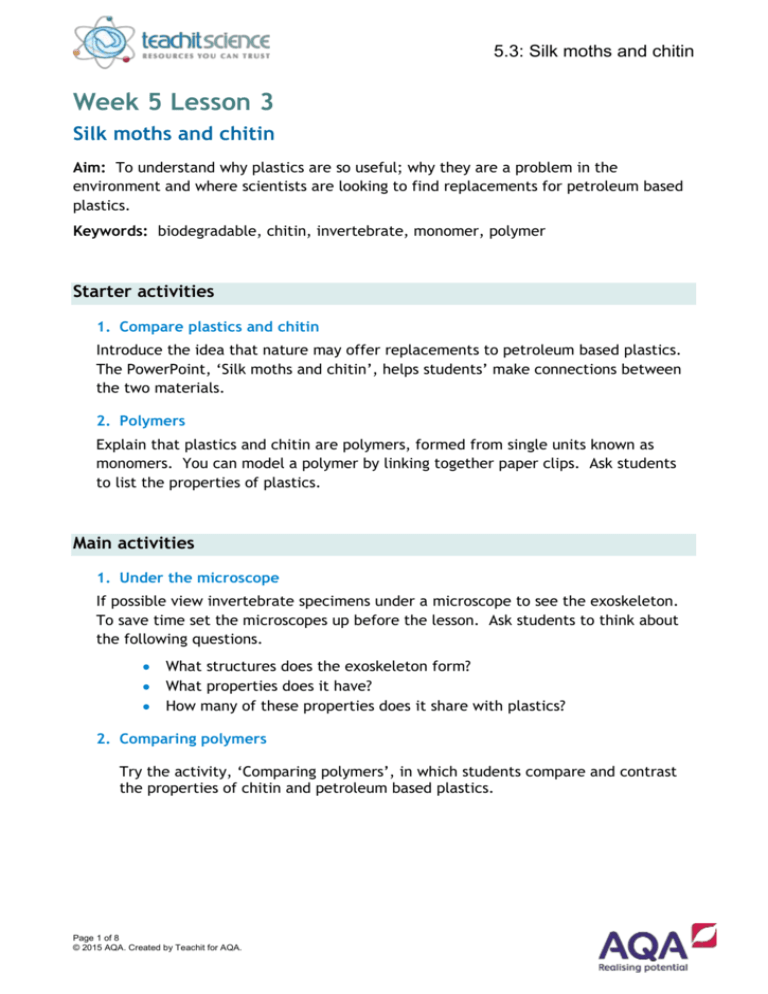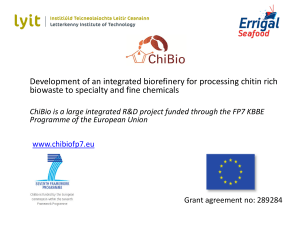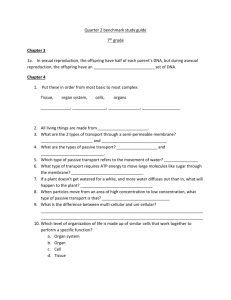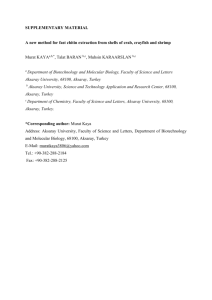Week 5 Lesson 3 Silk moths and chitin
advertisement

5.3: Silk moths and chitin Week 5 Lesson 3 Silk moths and chitin Aim: To understand why plastics are so useful; why they are a problem in the environment and where scientists are looking to find replacements for petroleum based plastics. Keywords: biodegradable, chitin, invertebrate, monomer, polymer Starter activities 1. Compare plastics and chitin Introduce the idea that nature may offer replacements to petroleum based plastics. The PowerPoint, ‘Silk moths and chitin’, helps students’ make connections between the two materials. 2. Polymers Explain that plastics and chitin are polymers, formed from single units known as monomers. You can model a polymer by linking together paper clips. Ask students to list the properties of plastics. Main activities 1. Under the microscope If possible view invertebrate specimens under a microscope to see the exoskeleton. To save time set the microscopes up before the lesson. Ask students to think about the following questions. What structures does the exoskeleton form? What properties does it have? How many of these properties does it share with plastics? 2. Comparing polymers Try the activity, ‘Comparing polymers’, in which students compare and contrast the properties of chitin and petroleum based plastics. Page 1 of 8 © 2015 AQA. Created by Teachit for AQA. 5.3: Silk moths and chitin Differentiation and extension Provide students who need support with a table of suitable headings to help them sort the statements. There are three questions on the sheet which use different command words, i.e. describe, compare and evaluate. Assign different students one or all of the questions to answer. It is a good opportunity to discuss what each of the command words is asking for. 3. Shrilk Students plan a pitch which outline the benefits of a new product called Shrilk, made from chitin and silk, using the resource ‘Shrilk’. 4. Polymer practical The Royal Society of Chemistry website (http://www.rsc.org/learn-chemistry) has a number of classic demonstrations and practical activities based on polymers such as making and testing 'slime'. There is a mathematical skills resource, ‘Maths and measuring volume’, to accompany this practical (or as a standalone activity) which could be easily adapted to use with other experiments. www.rsc.org/learn-chemistry/resource/res00000756/pva-polymer-slime Assessment opportunity The maths activity provides an opportunity to assess students’ basic number skills. Plenary activity 1. Match the Greek word with its meaning Many of the words we use today have their roots in ancient languages such as Greek and Latin. Use the ‘Matching’ activity on the interactive whiteboard to pair the Greek words with their meaning. Greek word Meaning plasticos khitōn skeletos organikos exōpolumeros to mould tunic dried up relating to an organ or instrument outside having many parts Ask students which words used in the lesson originate from these Greek words? Page 2 of 8 © 2015 AQA. Created by Teachit for AQA. 5.3: Silk moths and chitin Starter 1 Silk moths and chitin — PowerPoint Page 3 of 8 © 2015 AQA. Created by Teachit for AQA. 5.3: Silk moths and chitin Main 1 Comparing polymers Look at the statements below which show some of the properties of plastics and chitin. Cut up the statements and sort them into groups to show the similarities and differences between the properties plastics and chitin. Use the statements to help you answer the following. a. Describe the advantages of using plastic bottles for storing chemicals. b. A company manufactures disposable cutlery. Compare the advantages of using chitin or plastics to make the cutlery. c. Evaluate which material, chitin or plastic, would be best to use in the manufacture of a toy aimed at toddlers. Properties of petroleum based plastics: resistant to chemicals and water electrical and thermal insulator high strength-to-weight ratio most are non-biodegradable but can be recycled durable can be moulded into any shape additives to plastic can be toxic can be coloured Properties of chitin: resistant to water and some chemicals insulating properties are currently being investigated can be coloured non-toxic can form many shapes biodegradable durable high strength to weight ratio Page 4 of 8 © 2015 AQA. Created by Teachit for AQA. 5.3: Silk moths and chitin Main 3 Shrilk Many scientists are searching the plant and animal worlds in the hope of finding a material that has all the properties of petroleum-based plastics, yet is also fully biodegradable. They have turned to the world's second most abundant organic polymer – chitin. By combining chitin from shrimp shells and fibroin (a protein from boiled silkworm pupae), they have produced Shrilk. Now, they need to get their new product out into the manufacturing world. Can you persuade business to begin manufacturing Shrilk? Task You have been asked to attend a Plastics convention and trade exhibition at the NEC, Birmingham. You will have a trade stand and displays showing your new product. Can you seize the interest of passing business delegates and talk them into backing your product, Shrilk? Use the statements below to help build your pitch. Shrilk is tough Its flexibility can be altered by adjusting the water content It is flame retardant Shrilk can be injection moulded Chitosan (a derivative of chitin) can be stamp-moulded It can be transparent, translucent, opaque It is a thermal insulator The raw materials for Shrilk are the waste products from other industries It is fully biodegradable, forming a fertilizer which can be put on the land. 1. What is Shrilk's USP (unique selling point)? 2. How do you think the cost of manufacturing Shrilk will compare to the cost of traditional plastics? Page 5 of 8 © 2015 AQA. Created by Teachit for AQA. 5.3: Silk moths and chitin Main 4 Maths and measuring volume — Answers 1. a. 10 cm3 x number of students in class b. 40 cm3 x number in the class 2. a. 6 students b. 12 students c. Answer will depend on the number of students in the class 3. 15 cm3 4. 2.5 cm3 Page 6 of 8 © 2015 AQA. Created by Teachit for AQA. 5.3: Silk moths and chitin Maths and measuring volume These questions are based on a practical to make polymer slime. To make the slime each group needed 40 cm3 of polyvinyl alcohol and 10 cm3 of borax solution. 1. What would be the minimum amount of a) borax solution b) polyvinyl alcohol needed to make sure that everyone in the class has enough for their experiment? 2. On the day of the experiment the technicians could only make up 240 cm3 of polyvinyl alcohol. a. How many students could carry out the experiment individually? b. How many if they worked in pairs? c. How large would each group have to be if everyone were to be involved? 3. One member of the class used 60 cm3 of the polyvinyl alcohol instead of 40 cm3. How much borax solution would they need to add to make the correct mixture? 4. There is enough polyvinyl alcohol if everyone uses only 10 cm3. How much borax solution should be added to this? ------------------ -------------------------------------------------------------------------------------- Maths and measuring volume These questions are based on a practical to make polymer slime. To make the slime each group needed 40 cm3 of polyvinyl alcohol and 10 cm3 of borax solution. 5. What would be the minimum amount of a) borax solution b) polyvinyl alcohol needed to make sure that everyone in the class has enough for their experiment? 6. On the day of the experiment the technicians could only make up 240 cm 3 of polyvinyl alcohol. a. How many students could carry out the experiment individually? b. How many if they worked in pairs? c. How large would each group have to be if everyone were to be involved? 7. One member of the class used 60 cm3 of the polyvinyl alcohol instead of 40 cm3. How much borax solution would they need to add to make the correct mixture? 8. There is enough polyvinyl alcohol if everyone uses only 10 cm3. How much borax solution should be added to this? Page 7 of 8 © 2015 AQA. Created by Teachit for AQA. 5.3: Silk moths and chitin Plenary Match the Greek word with its meaning — Interactive To access this interactive resource, please go to www.teachitscience.co.uk/aqa-biomimicry Page 8 of 8 © 2015 AQA. Created by Teachit for AQA.








